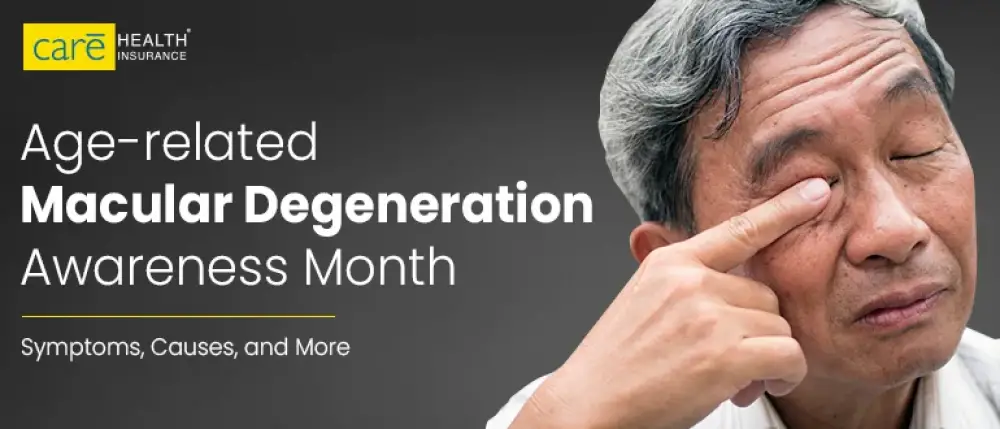Subscribe to get weekly insights
Always stay up to date with our newest articles sent direct to your inbox
Published on 11 Feb, 2025
Updated on 4 Mar, 2025
170 Views
3 min Read

Written by Jyotsana Shekhawat
Reviewed by Rashmi Rai
9Likes
Millions of people worldwide struggle with the threat of irreversible sight loss due to Age-Related Macular Degeneration (AMD). A progressive eye disease, AMD affects the macula—the central part of the retina—leading to blurred vision and, in severe cases, blindness. February is recognised as Macular Degeneration Awareness Month. It is a period to spread knowledge about the condition's symptoms, risks, and treatments.
While there is no outright cure for AMD, early detection and proactive care can help preserve vision. Understanding this condition and its symptoms and making lifestyle changes can help slow its progression.
Keep reading to learn more about macular degeneration symptoms, its causes, and its treatment.
Age-related macular Degeneration is a degenerative condition that damages the macular, impacting central vision. It primarily affects individuals over the age of 50 and is one of the leading causes of blindness among people from senior age groups.
There are essentially two types of AMD:
Symptoms of AMD can vary from one person to another, depending on various factors. Here are the common warning signs:
Note that these signs may not occur at the initial stage of AMD. That said, regular eye check-ups and consultations are key to keeping track of your eye health and proactively approaching treatment if needed.
AMD does not stem from a single known cause there are various risk factors associated with the likelihood of developing this condition. Mentioned below are the common reasons:
AMD diagnosis involves a series of eye tests to evaluate retinal health and identify early symptoms of the damage. Here below are the methods that ophthalmologists may use for age-related macular degeneration diagnosis:
Early diagnosis of AMD is crucial to prevent irreversible vision loss. Regular eye check-ups–especially for people over the age of 50—are the key to guarding against the damage.
While there is no dedicated way to cure age-related macular degeneration symptoms, there are treatment methods that can slow its progression. Here are the macular degeneration treatment options:
The treatment options can also vary from patient to patient–and depends largely on the outcome of the eye diagnosis.
Age-Related Macular Degeneration Awareness Month reminds everyone to look out for eye health and stay informed–and on guard—about eye diseases and treatment. The month encourages people to act proactively, opt for regular eye diagnosis, stick to healthy habits, and seek early treatment in case a symptom shows up.
Here are the easy-to-adopt ways to safeguard your vision:
Age-related macular degeneration is a serious condition that can leave an impact on one’s retinal well-being for a lifetime. The effects of this condition disrupt daily life, making it essential for you to watch over lifestyle choices. This also includes keeping a solid health insurance plan by your side so that the medical expenses do not pose a roadblock as you go out for screenings and treatments. Comprehensive health insurance plans by Care Health Insurance can help you save big time on soaring health-related expenses. So, while you choose a healthy diet to protect your vision, don’t forget to buy a health plan with eye coverage to save on out-of-pocket expenses.
>> Also Read: How Your Age affects the Health Insurance Premium?
Disclaimer: All plan features, benefits, coverage, and claims underwriting are subject to policy terms and conditions. Kindly refer to the brochure, sales prospectus, and policy documents carefully.
शुगर कंट्रोल कैसे करे? जानें, डायबिटीज में क्या खाना चाहिए Care Health Insurance in Health & Wellness
Thyroid : मामूली नहीं हैं महिलाओं में थायराइड होना, जानें इसके लक्षण और घरेलू उपचार Care Health Insurance in Diseases
हाई ब्लड प्रेशर को तुरंत कंट्रोल कैसे करें? देखें इसके उपाय Care Health Insurance in Diseases
प्लेटलेट्स की कमी के लक्षण, कारण और इलाज क्या है Care Health Insurance in Diseases
World Chagas Disease Day: Understanding Global Health Impact of Kissing Bugs Care Health Insurance in Awareness Days
World Parkinson’s Day: Raising Hope for the Elderly Care Health Insurance in Awareness Days
World Bipolar Day 2025: Understanding Bipolar Disorder and Breaking Stigma Care Health Insurance in Health Insurance Articles
ट्यूबरक्लोसिस (टीबी) के लक्षण, कारण और इलाज Care Health Insurance in Awareness Days